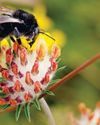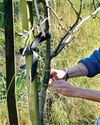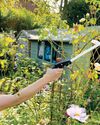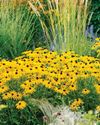
THERE’S a good basic principle to follow when using plant ties: never tie living plant material tightly. It should be secure, of course, so first your tie should be fastened tightly to the supporting cane or framework, and then loosely around the living stem you’re supporting. As the plant grows its stems thicken, and a tight tie will literally strangle it.
Two types of ties
A range of materials is used to make plant ties, some better suited to particular jobs. Some designs can be useful for particular projects, or to speed up the process of tying-in lots of stems.
Ties fall into two categories: those made from organic material that decomposes over the course of about a year; and those made from inorganic material that will last for several or many years. Organic materials include garden twine (made from jute) and raffia. Inorganic materials include flexible metal wire and plastic. The exception is rubber – often used for tree ties – which is organic, but can last many years.
Metal wire, plastic-coated or not, can be a risky material to tie plants with. It’s ideal for stretching across fence panels or walls to make plant supports or tying canes together to make wigwams and the like, but it is thin, so it can cut, and it has no ‘give’ once twisted around a stem.
This story is from the July 04, 2020 edition of Amateur Gardening.
Start your 7-day Magzter GOLD free trial to access thousands of curated premium stories, and 8,500+ magazines and newspapers.
Already a subscriber ? Sign In
This story is from the July 04, 2020 edition of Amateur Gardening.
Start your 7-day Magzter GOLD free trial to access thousands of curated premium stories, and 8,500+ magazines and newspapers.
Already a subscriber? Sign In

To dig or not to dig?
Should we be carrying out a full dig on plots now? Bob considers the pros and cons of the 'autumn dig' debate

The box ball blues
As if his beleaguered box hadn't already taken a beating, Toby now has to deal with some hungry box caterpillars

Save your own seeds
Masterclass on: seed saving

Strange sightings
Three unusual insects turn up in Val's garden in one day

A bolt from the blue!
Cornflowers are perfect for garden and vase

Winter moth prevention
Ruth shows you how to avoid maggoty tree fruits

Create a winter container
There are as many options as in summer

Lightweight gardening tools
AS well as being good for our mental health, gardening is also great exercise.

Autumn price round-up
AG finds better bargains in lesser-known brands

Rudbeckias
Rudbeckias are ideal for sunny summer patios and borders, with some able to survive our coldest winters